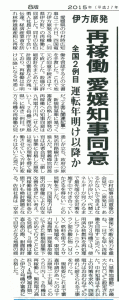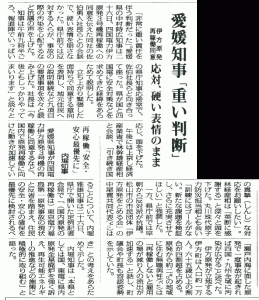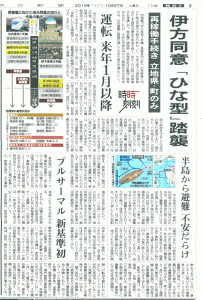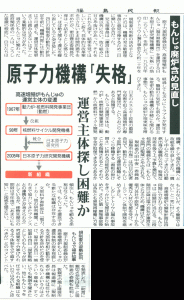Original Japanese written by staffer
The English below translated from the original Japanese by Heeday
The English translation edited by Rev. Dr. Henry French, ELCA
(Based on articles from the October 27th and November 5th editions of the Fukushima Minpo and Asahi Shimbun newspapers)
▼Click each image and read the caption.
Governor Tokihiro Nakamura of Ehime Prefecture, on October 26th, announced his agreement to the planned restart of Unit 3, Ikata Nuclear Power Plant of the Shikoku Electric Power Company (“NPP,” Ikata Town, Ehime). This is the second case where the governor of a prefecture where a NPP is located has agreed to the restart of the NPP (following that of Kyushu Electric Power’s Sendai NPP (Units 1 and 2), located in Satsumasendai City, Kagoshima Prefecture). Both restarts come after Japan has instituted its new regulatory standards for NPPs. In the coming months, the Nuclear Regulation Authority is to conduct examinations and follow the necessary approval procedures. Ikata NPP is expected to restart in or after January 2016.
More than four years have passed since the Fukushima Daiichi meltdown began, and still some 70,000 citizens of Fukushima Prefecture are in evacuation. Learning from this tragedy, the new regulatory standard legally requires that an evacuation plan has to be prepared for the residents who live within 30km (18.7 miles) of a NPP. Basically, the hosting and neighboring municipalities should draft such a plan, prepare for possible evacuations, and lead the affected residents in the case of a major accident. This time, however, the governor has won consent for the planned restart from the hosting municipality alone. Also, Japan has yet to secure a place for a final disposal site for high-level radioactive waste from reprocessed nuclear fuels. In spite of all these grave issues being unresolved, the restart procedure is already in process.
In reaching the agreement, Governor Nakamura successfully made Prime Minister Shinzo Abe pledge that the “national government should take responsibilities.” Located at the root of “Japan’s thinnest peninsula,” Sata Misaki Peninsula, Ikata NPP poses serious difficulties for residents should they need to evacuate in the case of a major accident. Considering how great and serious the devastations caused by the Fukushima meltdown are, it is obviously necessary to insist that the national government make evacuation plans and secure the implementation of such plans, for example, through amendments to the Disaster Countermeasure Basic Act.
Amid those moves and issues, the Nuclear Regulation Authority on November 4, 2015, decided to submit a recommendation to the Minister of Education, Culture, Sports, Science and Technology, who is responsible for the Monju Fast Breeder Reactor. One control and managerial error after another has occurred at the breeder reactor. The recommendation claims that the current operator of Monju, the Japan Atomic Energy Agency, is “not up to the job” and, therefore, argues that the Minister should find another operator within a half year or so. In case the Minister fails to do so, one possible option is to decommission the breeder reactor. This is the first recommendation the recently installed Authority has ever submitted.
We have yet to see any conclusion to Fukushima’s radioactive contamination problems. With numerous problems remaining unresolved, there are nevertheless moves to restart Japan’s existing NPPs. I pray there never be another Fukushima.





